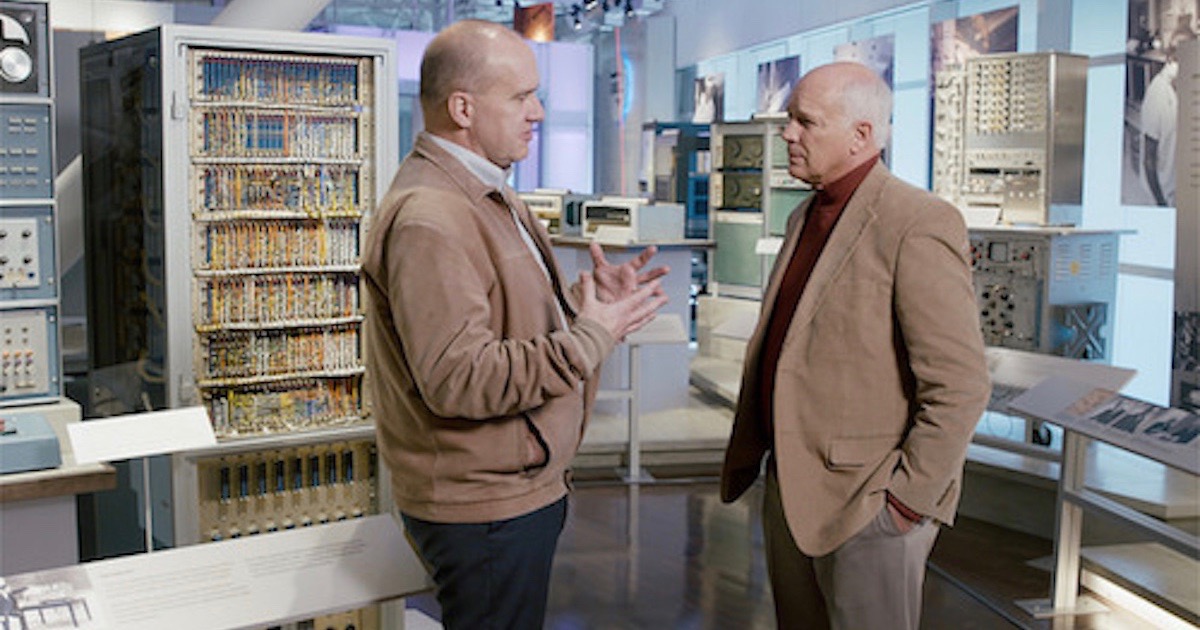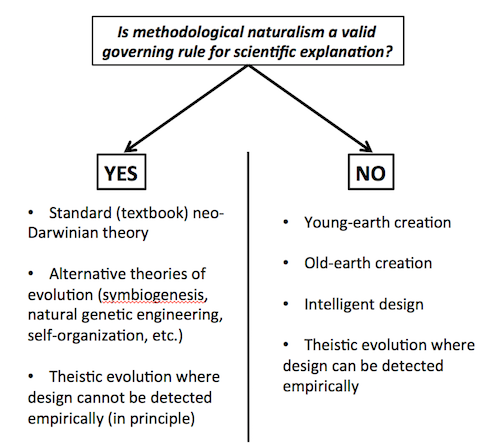 Evolution
Evolution
 Faith & Science
Faith & Science
 Intelligent Design
Intelligent Design
New Film Is Genesis History? Presents a False Dichotomy: I Dissent from My Role in It

In 2014, producer Thomas Purifoy of the media company Compass Cinema contacted me about a film he was planning, to look at the scientific, philosophical, and theological case for an “historical Genesis” interpretation of Earth history. I thought the project sounded interesting, and agreed to suggest scientists Purifoy might interview, and to be interviewed myself. Today, nationwide, that film — Is Genesis History? (hereafter, IGH) — is being released in theaters.
As I explain below, I must dissent from my role in the production.
1. The false dichotomy problem in Is Genesis History?
Although IGH is in many respects a very beautiful film, with stunning footage and fascinating interviews, my section of the movie needs to be revised, because it presents a false dichotomy.
Here is the problem. I am interviewed as saying that the origins debate is a choice between two “paradigms” — the “conventional paradigm” and the “historical Genesis paradigm.” However, as IGH defines these two positions, the dichotomy places together what are actually fundamentally different viewpoints (see below and Figures 1 and 2). To put the matter as plainly as possible, what I say about only “two paradigms” is not true, and I have recommended that it be corrected by the film’s producer and director, Thomas Purifoy, before the DVD is released. We have spoken about this, so my statement is not a surprise to him.
I must accept my share of responsibility for this error, and regret that so many people will hear me say something I do not believe to be accurate. Throughout my thirty years in the intelligent design and “creation/evolution” discussion, I have consistently explained that, given one’s assumptions, an array of differing positions — more than two, certainly — exist concerning origins. While my published writings addressing the age of the Earth and cosmos are not extensive — a single online article and two book chapters — in every case, and in my public lectures, I have argued that multiple viewpoints exist within Christianity, and the culture at large, about origins. In hindsight, on December 1, 2015, in Mountain View, California, when I was interviewed, I should have insisted on expressing my own convictions so clearly that they could not possibly be misinterpreted; that I failed to do so is ultimately my own responsibility. I will now do whatever I can to remedy the mistake.

Figure 1.
Following a February 7, 2017 preview screening of IGH at the Creation Museum in Kentucky, and after seeing the film’s advertising and promotional materials, I became concerned about the false dichotomy, and sent a detailed (2,100 word) memo to Compass Cinema, asking that my interview segment be modified by adding narration. The company replied that IGH could not be changed so close to its release date. Given that IGH will continue to be screened, however, in churches, private schools, and homes for years to come, I have urged Thomas to revise the film before the DVD version comes out, to remove the false dichotomy.
2. The “two paradigms” defined — and the false dichotomy that ensues
In my interview segment of IGH, which occurs about 13 minutes into the film, I introduce Thomas Kuhn’s famous concept of a “paradigm,” described as a “framework within which evidence is interpreted.” I then characterize two competing paradigms concerning origins: the “conventional paradigm” versus the “historical Genesis paradigm.” The conventional paradigm includes “deep time,” i.e., the standard 13.7 billion year history for the universe, with the Earth forming at 4.6 billion years ago, and life and animals originating later — and “all the complexity of life [constructed] by strictly physical processes,” with no intelligent design involved.
This “and” in IGH‘s definition of the “conventional paradigm” brings together acceptance of a long time scale with an assertion of “no design,” thereby creating the false dichotomy. (See Figure 2.) But well before Charles Darwin wrote the Origin of Species, many natural historians and scientists held to long spans of time in Earth history, while also asserting that divine action was needed to explain (for instance) the origin of humans. The geologist Charles Lyell (1797-1875), for example, chief among Darwin’s most intimate circle of friends, never accepted a fully naturalistic (or “no design”) account of origins. Nor did Alfred Russel Wallace (1823-1913), co-discoverer of natural selection, much to Darwin’s annoyance: Wallace accepted an old Earth and evolutionary relationships, but denied that natural selection or any strictly undirected physical process alone could explain biological diversity and human uniqueness. Biology required intelligent design, whatever the time scale of events in Earth or cosmic history happened to be.

Figure 2.
Today a broad spectrum of opinion about time scales and intelligent design exists. Scholars and scientists such as William Lane Craig, Alvin Plantinga, Michael Behe, Hugh Ross, John Bloom, Fuz Rana, Phillip Johnson, Jonathan Wells, Stephen Meyer, Guillermo Gonzalez, John Lennox, and many thousands of others see unmistakable evidence of design in biology and the universe — but also accept the standard 13.7 billion year time scale. These persons would vigorously deny that their positions are accurately represented by either the “conventional paradigm” or “historical Genesis paradigm” as defined by IGH.
3. So what is an accurate description of the current philosophical and scientific landscape of opinion about origins?
We want a classification of differing positions that does not lump together what are, in fact, fundamentally opposed views about the history of the universe, the Earth, and life. No one would classify animals based solely on their color — say, “brown” versus “white” versus “black” animals — because the resulting groups would include wildly divergent types. Color is a superficial characteristic, compared to other, more important features of animals.
Likewise, we should organize the range of current opinion about origins around the deepest or most significant differences that separate positions — and that isn’t the time scale involved. In 2006, Liberty University paleontologist Marcus Ross (also interviewed in IGH) and I published a commentary on the thinking of UC Berkeley law professor Phillip Johnson. We pointed out that in the early 1990s, Johnson had rearranged the terms of the origins debate by helping people to see that the temporal narrative or time scale of origins, while important, was not the key difference between evolution and creation:
The fundamental difference between the two theories, Johnson argued, did not stem from any particular historical narrative, but rather from what kinds of causes would be allowed in scientific explanation and what would count as evidence. Epistemology — namely, what can be known empirically, and what counts as a scientific explanation — is what truly cuts the origins issue at its joints.1
This reading of the debate reflects what I had earlier published (in 1999 and 2002) about the question. Acceptance of methodological naturalism (MN) — namely, the philosophical rule that “the statements of science must invoke only natural things and processes”2 — separates, on the one hand, the intelligent design community, young-Earth and old-Earth creation, and those forms of theistic evolution where design is empirically detectable, from, on the other hand, textbook neo-Darwinism, all alternative theories of evolution, and theistic evolution where design cannot in principle be detected. (See Figure 1.)
That divide — MN or not — is where the origins issue is truly joined. Notice what happens, however (see Figure 2), if we classify theories according to the time scale they adopt. What are actually entirely different theories, resting on opposing philosophies of science, end up lumped together.
If we can detect design, the evidence has a chance to speak for itself. If we cannot detect design, it really doesn’t matter what the evidence is, no matter how dramatic. Therefore every other question, including the time scale, lies downstream of this fundamental distinction.
Readers who want to pursue this issue in greater depth should consult Marcus Ross’s helpful 2005 article, “Who Believes What? Clearing Up Confusion About Intelligent Design and Young-Earth Creation.”
Notes:
(1) Marcus Ross and Paul Nelson, “A Taxonomy of Teleology: Phillip Johnson, the Intelligent Design Community and Young-Earth Creationism,” in W. Dembski, ed., Darwin’s Nemesis (Downers Grove, IL: InterVarsity Press, 2006), pp. 261-75; p. 263.
(2) Working Group on Teaching Evolution, National Academy of Sciences, Teaching About Evolution and the Nature of Science (Washington, DC: National Academy Press, 1998) p. 42.
Image: Paul Nelson and Del Tackett in Is Genesis History?, courtesy of Compass Cinema via Flickr.
